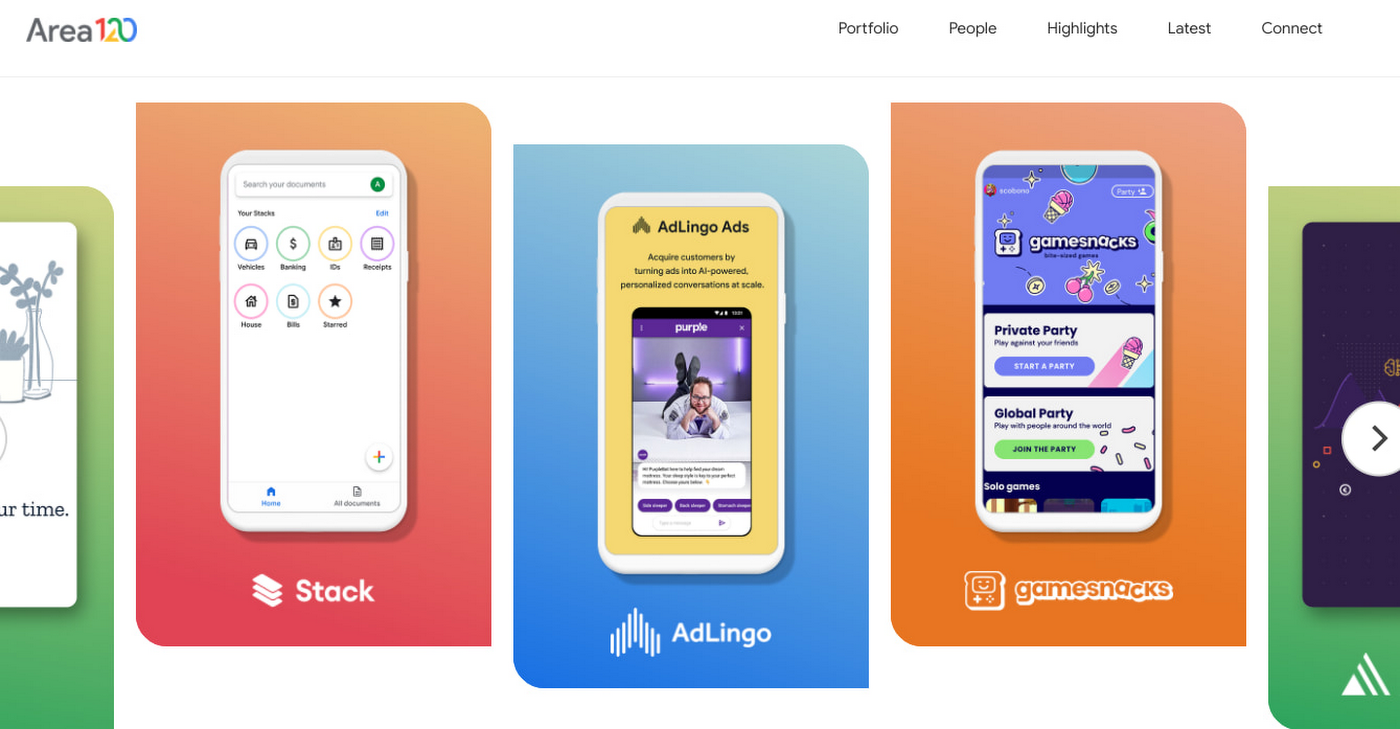5 lessons from Google’s Area 120 incubator on sustaining innovation at scale

Natalie Piucco
Cloud CTO Strategic Advisory, Customer Engineering
Google’s Area 120 incubator shares 5 lessons on sustaining innovation at scale
CIOs often ask Google Cloud: How do you maintain an entrepreneurial spirit and continue to innovate at enterprise scale?
For us, one of the answers has long been our famous “20% time.” For those unfamiliar, this is where employees use 20% of their work time on business-related assignments that might add value to the company. It has led to many successful projects, including Gmail and Google News. As the company scaled, we’ve continued to lean into the concept of 20% time to allow employees to flex their entrepreneurial muscles and innovate within Google, with all the resources we can bring to bear.
One example is Area 120, our in-house incubator where Googlers work on 20% projects, 100% of the time.


Area 120 was built to provide a purpose-built home for bottom-up innovation at Google. Its job is to take an idea from "zero to one" — proving out that there is a viable Google product opportunity. It funds projects that have impact by bringing learnings, people, and products back into the relevant Google product areas to scale. Twice a year, any Googler can pitch a potential project idea to Area 120 partners. The organization evaluates applications by team and how well the project could fit within key product areas at Google. Projects that enter the program are supported with leadership expertise, technological and financial resources. All Area 120 projects are reviewed regularly and successful projects eventually transition out across Google. Examples include: Tables and AdLingo into Cloud, Shoploop into Commerce, and GameSnacks into ads. Current teams include Checks, a privacy platform for mobile app developers, and Aloud, a creator tool to dub videos into additional languages.
That Digital Show podcast sat down with Area 120 to take a peek behind the scenes. Below are five lessons we’ve learned from the team about innovation that may be helpful in driving innovation at scale in your company.
1. Have visible and active entrepreneurial leadership
You don’t create a culture of innovation out of thin air. What you do instead is define company values and give smart, capable people the tools and time to explore new areas of innovation, being a champion for the type of behavior you want to see.
It’s important to ensure that your mission clearly aligns with the company’s culture of innovation. We believe that it’s important for leaders to “walk the walk” in terms of supporting entrepreneurial behavior. In addition, it is critical to understand that innovation and invention is not the only way to be an entrepreneur. Area 120 actively encourages the entrepreneurial-minded to have a level of cross-company collaboration that can facilitate how we find solutions to challenges or new areas of opportunity for our products.
Ultimately, entrepreneurship is about solving problems with new, creative solutions. Company leadership should give people the freedom to explore new solutions, allowing them the room to build on their ideas.
2. Innovation isn’t automatic, and it isn’t magic
There’s no right or wrong way to innovate: It’s difficult. It takes time and resources and a mindset to let ideas grow to fruition yet also the courage to pull the plug when things aren’t working.
Ideas need to be nurtured. Ideas need to grow through established and proven processes. To bring ideas to fruition, we help build full-stack teams that are responsible for solving user problems. At Area 120, those teams start small, typically composed of engineers, and often a product manager and User Experience team member. We empower them to operate as small, autonomous Google teams.
They need room to breathe, which is why Area 120 operates like an incubator, providing the time and investment, and ensuring the right team composition for the best possible chance of success. Area 120 will ask critical questions of teams to offer them the utmost guidance and support, but avoids tinkering for too long. It holds to the “fail fast” mentality while keeping disciplined evaluation metrics. Failure is an expected part of the process.
3. Incubate at arms length, but not too far
Leaders of large organizations need to be able to manage the delicate balance of giving projects the room they need to grow while also knowing they will eventually need to be more broadly adopted by the business.
A delicate dance often happens between managing ideas so they are not so far removed from the company’s objectives that they aren’t relevant, versus not being too close to home so that they step on toes or stifle innovation.
In the early days, Area 120 had its own building and badges. Over time it discovered that teams working together in virtual or physical spaces with branches outside the incubator into Google, works best. It also found that it was more successful to bring in potential product owners as advisors early on, often with double reporting lines to formalize input.
4. Have a clear criteria for evaluating ideas
There are many ways to evaluate internal ideas. Area 120 evaluates across four broad categories:
Team and problem: Does the team have the domain expertise and skill set required to solve the problem? Does the team have a close connection to solving this problem?
Value creation: Is there a strong belief there is a large, unsolved problem? If that problem were to be solved would it create new value in the world? Will that value be able to be distributed for customers and users?
Company fit: You might be incubating projects to join your existing product portfolio, so it’s important to have a very clear understanding of how projects may graduate back into your company.
Area 120 fit: How do the ideas match with the skills of the supporting team and available resources? How much time will it take? What’s the capital expenditure required?
5. Celebrate high-impact thinking
An internal incubator process like Area 120 is not the only way to drive a culture of innovation within an organization and it may not fit the business you lead. What we have also learnt is that Innovation is not a moment in time, its not just a hackathon or getting together once or twice a year with your team to think big. Innovation is a mindset.
At its essence, we believe in encouraging high impact thinking and measuring innovation in a way that works best for your company. This may look like finding ways to include high-impact goals into key performance indicators to encourage your teams to think outside their everyday role.
Different parts of Google have implemented this in different ways. At Google Cloud we include a category of “10x thinking” as part of our twice yearly employee reviews where Googlers describe where they have been involved in cross-functional teams solving for a bigger business problem outside their core role.
Want to learn more about innovation at Google? Check out our five-party Digital Master Class podcast series on “open sourcing” practical lessons for leaders on how Google builds, scales product, hires talent, grows ideas, and sustains a culture of innovation.



